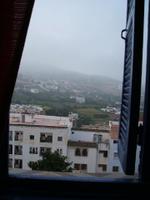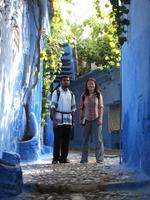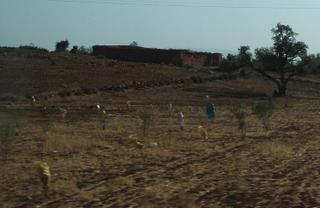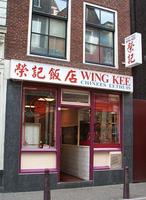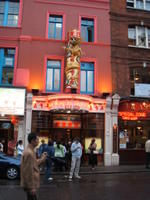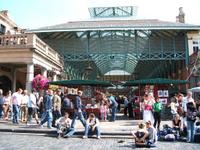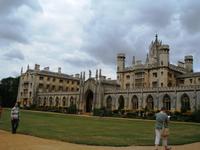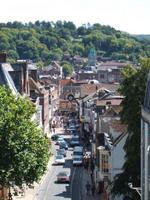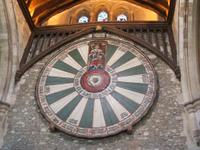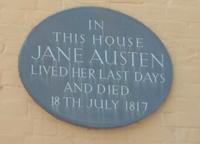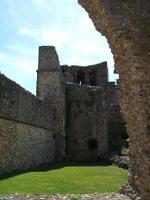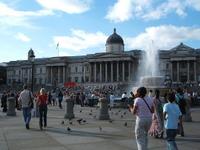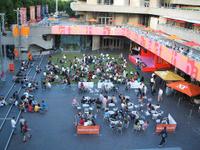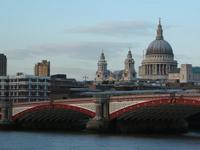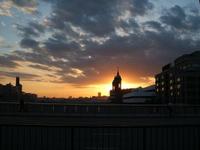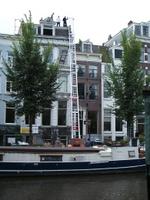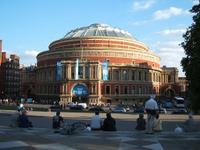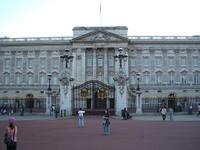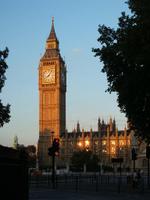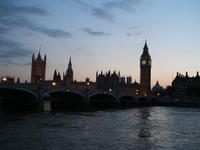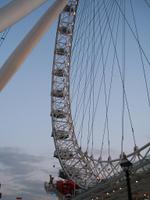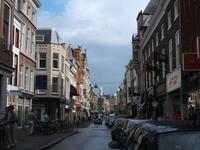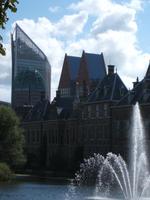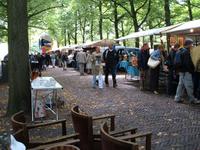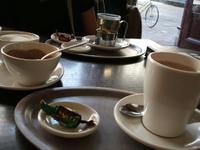Aug 16 - To Meknes
 After lunch, we encounter our first transportation crisis – the bus headed to Meknes is full - it does not originate in this town, so it has already filled up on its way here. And while it seems that people got on the filled bus at Tangier anyways, that’s not the way things are done here. What do we do? Drag our suitcases back up the steep hill and stay another night? Try for a bus to another town? Not quite panicking yet, since we still have most of the day ahead of us, we ask a policeman at the bus station what our options are. He introduces us to the wonderful system of ‘grand taxis’ (as in the French for big), giving us the best route (split the journey into 2 legs, first to Ouezzane, where we can either take another taxi or a bus to Meknes) and what we should even expect to be charged. He was incredibly helpful and even helped us find a petit taxi to the taxi station. (See petit taxis in Tangier to the left).
After lunch, we encounter our first transportation crisis – the bus headed to Meknes is full - it does not originate in this town, so it has already filled up on its way here. And while it seems that people got on the filled bus at Tangier anyways, that’s not the way things are done here. What do we do? Drag our suitcases back up the steep hill and stay another night? Try for a bus to another town? Not quite panicking yet, since we still have most of the day ahead of us, we ask a policeman at the bus station what our options are. He introduces us to the wonderful system of ‘grand taxis’ (as in the French for big), giving us the best route (split the journey into 2 legs, first to Ouezzane, where we can either take another taxi or a bus to Meknes) and what we should even expect to be charged. He was incredibly helpful and even helped us find a petit taxi to the taxi station. (See petit taxis in Tangier to the left). As I mentioned before, ‘grands taxis’ are inter-city taxis (see right), while ‘petits taxis’ are intra-city. Grands taxis are found at taxi stations (parking areas) within each city. Travelers go to the stations and tell someone what city they want to go to and whether they want to go ‘solo’ (charter the whole taxi) or ‘distributif’ (only a certain number of seats) because payment is by seat. Each taxi leaves only when all the seats are paid for which means 6 seats – 2 in the passenger seat and 4 in the back. It becomes a waiting game as the drivers see whether we will give in and pay for the extra seats just to get going, while we wait in hopes of other passengers. We are somewhat in luck this time around, as a middle-aged couple also wants to go to Ouezzane. After 20 minutes waiting in the hot sun, we opt to pay for the 4th back seat and ride there in relative comfort.
As I mentioned before, ‘grands taxis’ are inter-city taxis (see right), while ‘petits taxis’ are intra-city. Grands taxis are found at taxi stations (parking areas) within each city. Travelers go to the stations and tell someone what city they want to go to and whether they want to go ‘solo’ (charter the whole taxi) or ‘distributif’ (only a certain number of seats) because payment is by seat. Each taxi leaves only when all the seats are paid for which means 6 seats – 2 in the passenger seat and 4 in the back. It becomes a waiting game as the drivers see whether we will give in and pay for the extra seats just to get going, while we wait in hopes of other passengers. We are somewhat in luck this time around, as a middle-aged couple also wants to go to Ouezzane. After 20 minutes waiting in the hot sun, we opt to pay for the 4th back seat and ride there in relative comfort.  In Ouezzane, we are in luck that the taxi station is next to the bus station, though the parking lots are unpaved so we do a lot of suitcase lugging. We discover the system at this bus station is nonexistent. We cannot buy tickets until the bus arrives and everyone tells us different ETAs for the Meknes bus. We decide to wait till the first ETA before trying for a taxi (pic is of us at station), but one of the ppl we had asked went and got us 3 seats on a grand taxi without us asking (he wanted a 10Dh tip for it). This ended up working quite nicely since it was a full car, though it was a very cramped, sticky 2 hour ride.
In Ouezzane, we are in luck that the taxi station is next to the bus station, though the parking lots are unpaved so we do a lot of suitcase lugging. We discover the system at this bus station is nonexistent. We cannot buy tickets until the bus arrives and everyone tells us different ETAs for the Meknes bus. We decide to wait till the first ETA before trying for a taxi (pic is of us at station), but one of the ppl we had asked went and got us 3 seats on a grand taxi without us asking (he wanted a 10Dh tip for it). This ended up working quite nicely since it was a full car, though it was a very cramped, sticky 2 hour ride. We settled into our hostel at Meknes and walked down to the medina in search of phones and dinner. At this point we have figured out the teleboutique system. You walk in, plunk down a bill on the counter and ask for however much change you need in coins. Collecting your pile of 1, 5 and 10Dh coins, you walk into one of the booths and dial. Local, national and international calls all have base starting amounts, then you go by time. I just remember that international ones start a 5Dh and that gets you maybe 30s of airtime.
We settled into our hostel at Meknes and walked down to the medina in search of phones and dinner. At this point we have figured out the teleboutique system. You walk in, plunk down a bill on the counter and ask for however much change you need in coins. Collecting your pile of 1, 5 and 10Dh coins, you walk into one of the booths and dial. Local, national and international calls all have base starting amounts, then you go by time. I just remember that international ones start a 5Dh and that gets you maybe 30s of airtime.  Meknes was our first exposure to the hubbub of Moroccan cities after dark – when they truly come to life. The streets fill with families, tourists, young people strolling, shopping, eating and having a good time. Dinner was at ‘Chez Oumnia’ – a small family owned place recommended by Lonely Planet. This is where we had our first harira, couscous (previously pictured) and where we saw mint tea poured from high for the first time.
Meknes was our first exposure to the hubbub of Moroccan cities after dark – when they truly come to life. The streets fill with families, tourists, young people strolling, shopping, eating and having a good time. Dinner was at ‘Chez Oumnia’ – a small family owned place recommended by Lonely Planet. This is where we had our first harira, couscous (previously pictured) and where we saw mint tea poured from high for the first time.Next - Aug 17 - Meknes
